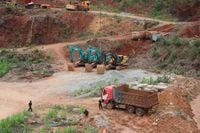In a significant move aimed at countering China’s dominance in the strategic metals market, the European Union and the United States have agreed to form a new strategic metals alliance. Announced by European Trade Commissioner Maros Sefcovic on July 28, 2025, this alliance seeks to replace the contentious 50% import tariffs on European steel and aluminium imposed by former US President Donald Trump with a quota-based system that offers minimal or zero tariffs to EU metal producers.
This agreement marks a major shift in transatlantic trade relations, creating what Sefcovic described as a "joint ring-fence around our respective economies through tariff rate quotas at historic levels with preferential treatment." The alliance covers steel, aluminium, copper, and their derivatives, and represents a unified front between the EU and US to protect their domestic steel and metals sectors from the effects of Chinese overcapacity and heavily subsidised production.
"It became very, very clear that when it comes to steel and metals, we are not each other’s problem," Sefcovic told reporters, underscoring the shared challenges both economies face. The urgency for Europe is heightened by American plants drawing critical scrap metal supplies away from EU smelters—a resource vital for cost-effective and environmentally efficient metal recycling.
This transatlantic cooperation is part of a broader Western effort to address global economic imbalances, highlighted at the G7 finance ministers’ meeting in May 2025, where excessive imbalances linked to Chinese subsidies were a key concern. However, as Sefcovic lamented following the EU-China summit held from July 21-27, 2025, progress with Beijing remains elusive. "Despite the strenuous efforts of my colleagues and myself, and several long meetings with my Chinese counterparts, the list of accumulated issues did not get shorter—it just grew longer," he said, pointing to overcapacity and illegal subsidies as core problems.
While the EU and US forge this alliance, attention is also turning to new critical mineral discoveries that could reshape global supply chains. In northern Quebec, Patriot Battery Metals has announced the world’s largest known deposit of pollucite-hosted caesium, a critical metal essential for solar, defense, and medical technologies. CEO Ken Brinsden described the find as "likely the largest discovery, certainly in the last 30 or 40 years," with the CV13 pegmatite zone hosting 693,000 tonnes of indicated resources at 4.40% Cs₂O and 1,698,000 tonnes inferred at 2.40% Cs₂O, totaling 71.3 kilotonnes of contained caesium oxide.
Caesium is among the most supply-constrained critical minerals, trading at over $2,500 per ounce, with prices surging in 2025 due to depleting inventories from legacy producers. Brinsden emphasized that while lithium remains the company's primary focus—with a lithium-only feasibility study expected in Q3 2025—the multiple co-products including tantalum, gallium, rubidium, and caesium offer significant economic upside. Volkswagen’s PowerCo unit has already acquired a 9.9% stake in Patriot Battery Metals, securing offtake rights and funding support, with plans for expanded collaboration.
Despite the promise, Brinsden expressed frustration with Canada’s slow permitting processes compared to global competitors, warning that "if you want to be serious about supplying the Western world with critical minerals, you’ve got to make it easier to permit." With only 6.5 kilometers of the project’s 20 kilometers drilled so far, expansion is anticipated as drilling continues.
Meanwhile, across the globe, India faces its own critical mineral challenges. The State Bank of India (SBI) has issued a stark warning about China’s recent export ban on rare earth elements and permanent magnets, a move that threatens to disrupt India’s manufacturing sectors and financial system. The SBI report titled "China’s Ban on Rare Earth and Permanent Magnets: Implications for India," published on July 28, 2025, highlights India’s near-total import dependency on China for these essential materials.
Rare earth elements are vital for electric vehicles, wind turbines, electronics, defense equipment, and medical devices. India imported $31.9 million worth of rare earth compounds in FY24-25 and an unprecedented $291 million in rare earth magnets, the highest in four years. The report warns that supply shocks could elongate working capital cycles, increase credit demand volatility, and push financial stress across industries and banks, especially those linked to trade and exports.
In response, the Indian government launched the National Critical Mineral Mission (NCMM) in 2025, allocating Rs18,000 crore for 2025–2031 to foster self-reliance. States like Odisha are leading with policies prioritizing rare earth-based products and approving large-scale titanium manufacturing facilities. The Union ministry of mines has identified 30 critical minerals, including 17 rare earth elements targeted by China’s export restrictions, such as neodymium and dysprosium.
The SBI report emphasizes the need for banks to develop dedicated risk management frameworks and financing strategies to support the domestic critical minerals value chain. It also notes that price volatility of key minerals complicates planning and costs for manufacturers, urging India to follow the lead of the US, Japan, and EU, who are investing heavily in alternative supply chains.
On the strategic front, the United States is exploring ways to reduce its reliance on China for heavy rare earths, which are crucial for high-performance weaponry and advanced technologies. The Trump administration has considered proposals to engage with Myanmar’s Kachin Independence Army (KIA), which controls most of the country’s rich deposits of heavy rare earths, in an effort to divert supplies away from China. These proposals include negotiating peace deals between the Myanmar military junta and the KIA or working directly with the KIA, despite Washington’s longstanding avoidance of direct talks with Myanmar’s military leaders following the 2021 coup.
Adam Castillo, a US business lobbyist, suggested that the US could play a peace broker role in Myanmar, advocating a bilateral self-governance deal akin to China’s approach. He highlighted that ethnic armed groups are tired of Chinese exploitation and are eager to collaborate with the US and its Quad partners—India, Australia, and Japan—for processing and supply chains. Discussions have also involved Sean Turnell, a former adviser to Aung San Suu Kyi, who urged continued US support for Myanmar’s democratic forces and access to rare earths through the KIA.
However, logistical challenges abound. Myanmar’s mountainous terrain and limited infrastructure pose significant hurdles to transporting rare earths from Kachin State to India and beyond. Experts warn that Chinese intervention to block such supply routes is highly likely, given the proximity to the Chinese border and strategic interests.
Meanwhile, the Myanmar junta has shown signs of seeking engagement with Washington, especially after Trump’s July 2025 threat of 40% tariffs on Myanmar’s US-bound exports. The junta’s chief Min Aung Hlaing praised Trump’s leadership and requested tariff reductions and sanctions relief, even offering to send a negotiating team to Washington.
As the global race for critical minerals intensifies, these developments underscore the complex interplay of geopolitics, trade policy, and resource security. From the EU-US metals alliance and Canadian mineral discoveries to India’s strategic policy responses and US maneuvers in Myanmar, the scramble to secure critical minerals is reshaping international relations and economic strategies in profound ways.
Each player is navigating a delicate balance—pursuing resource independence, countering China’s dominance, and managing the geopolitical risks inherent in these vital supply chains. The coming years will likely see intensified cooperation, competition, and innovation as the world grapples with the critical minerals that power modern technology and defense.




